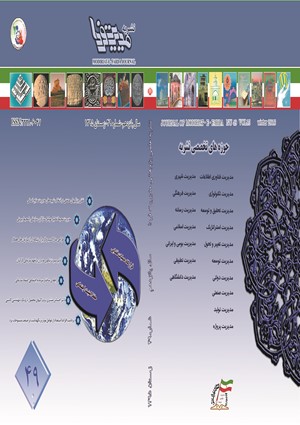ارایه یک مدل ارزیابی کارآفرینی سازمانی با رویکرد مدل تعالی سازمانی (EFQM) با استفاده از تکنیک یکپارچهسازی دیمتل و فرآیند تحلیل شبکهای فازی (F.D.ANP)
محورهای موضوعی :
1 - دانشگاه آزاد اسلامی واحد علوم تحقیقات
کلید واژه: کارآفرینی سازمانی, مدل تعالی سازمانی EFQM, فرآیند تحلیل شبکهای فازی, دیمتل فازی,
چکیده مقاله :
تغییرات و تحولات پر شتاب دنیای کنونی، نحوه رقابت شرکتها را دگرگون ساخته و ذینفعان سازمانی را در مواجهه با دنيايي پر از چالش قرار داده است. در این محیط پر از تلاطم، كارآفريني سازمانی قابليتي است كه به عنوان پديدهاي نوين در اقتصاد، ميتواند نظامهاي امروزي را در اين برهه حساس، نجات داده و نقش موثرتری در توسعه و پيشرفت اقتصادي كشورها ايفا نماید. امروزه مدلهای تعالی سازمانی نیز از نقش موثری در اشاعه عوامل کلیدی موفقیت سازمانی برخوردارند و بهبود عملکرد را به ارمغان میآورند. این مدلها با ارایه معیارهای ارزیابي در دو بخش توانمندسازها و نتایج، خطوط راهنمایي برای سازمانها ایجاد نموده اند تا آنها بتوانند پیشرفت و عملکردهای خود را در زمینه کیفیت و تعالي سازماني اندازهگیری نمایند. پس با اتکا بر توانمندسازهای مدل تعالی سازمانی EFQM میتوان زیرساختها و قابلیتهای مورد نیاز کارآفرینی سازمانی را ایجاد نمود. لذا پس از شناسایی عوامل موثر بر پیادهسازی کارآفرینی سازمانی، این ویژگیها با توجه به ماهیتشان در 4 معیار اصلی "رهبری"، "خط مشی و استراتژی"، "کارکنان" و "شراکتها، منابع و فرآیندها" که همگی از ارکان توانمندساز مدل EFQM است، دستهبندی میشوند. این مقاله یک روش مدلسازی تحلیلی است که روابط بسیار کیفی میان عناصر کارآفرینی را عملیاتی میسازد. جهت تعیین روابط علی و معلولی و ضرایب وزنی اهمیت نسبی هر عنصر در مدل، از رویکرد یکپارچهسازی دیمتلفازی و مدلسازی فرآیند تحلیل شبکهای فازی استفاده شده است. نتایج حاکی از آن است که در سطح معیارهای اصلی، "رهبری" دارای بیشترین شدت اثرگذاری و معیار "کارکنان" دارای بیشترین ضریب وزنی اهمیت نسبی است. همچنین در بخش زیرمعیارها "حمایت مدیریت ارشد" از لحاظ ضریب وزنی اهمیت نسبی و شدت اثرگذاری رتبه نخست را به خود اختصاص داده است. مدل ارزیابی کارآفرینی سازمانی ارائه شده در پژوهش مدلی جامع است که قابلیت بکارگیری در سازمانهای مختلف را دارد. این مدل در سازمان توسعه برق ایران مورد ارزیابی قرار گرفته است.
In today's world, quick changes have varied the competition and also have faced organizational stakeholders with world’s challenges. In this turbulence environment, Intrapreneurship is functionality that can save today's systems as a new phenomenon in the economy at this critical period and play a more active role in economic development. Today, business excellence models also have an important role to deploy the key factors of organizational success and make performance improvements. These models provide the assessment criteria in both enablers and results and make guidelines for organizations to measure their progress and performance in the field of quality and organizational excellence. So it allows creating the needed infrastructure and capabilities for Intrapreneurship based on the EFQM Excellence Model. Therefore, after identifying the effective factors of implementation Intrapreneurship, these features are classified due to their nature at four main criteria include "leadership", "Policy and Strategy", "employees" and "partnerships, resources and processes" that all of them are the enablers of the EFQM model. This paper presents an analytical modeling method that makes practicable a qualitative relationship between the elements of Intrapreneurship. We used the integrated approach of fuzzy Dematel and fuzzy modeling network analysis to determine the relationship and weight relative importance of each element in model. The results indicated “leadership” at the main criteria level has the most highly effect and “employees” has the most important coefficient. Also "senior management support" has the highest importance coefficient and highly effect in the sub-criteria. In this study we presented individual entrepreneurs and Intrapreneurship assessment model that is a comprehensive model and can be used in different organizations and finally we evaluated this model in Iran Power Development Company.


